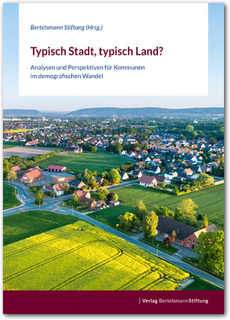Cities and towns have been the centers of social, cultural and economic change for generations. They represent tradition and conservation – but also new beginnings and progress. Especially now, municipalities have become focal points for the major collective challenges of our time, such as climate change, demographic change and digital transformation. That is why they are the places where trends and change processes can be seen, and where innovative approaches can be tested to provide public services that are integrated, sustainable and community-oriented.
![[Translate to English:] Landschaft](/fileadmin/files/_processed_/9/0/csm_AdobeStock_252046738_KONZERN_ST-CC_bearb_Original_96691_de61018c22.jpg)
© Christian Schwier - stock.adobe.com
Typical city, typical country?
A shortage of skilled workers, too few caregivers, growing and shrinking populations – those are only some of the aspects of demographic change that Germany’s cities and towns will continue to face in coming years. Eleven demographic types covering some 3,000 communities can help to identify how the situation varies by region and which factors are essential for analyzing conditions and developing potential.
Content
Typical city, typical country?
In terms of their social, economic and demographic development, municipalities exhibit numerous differences – and commonalities – on a regional level. Using data from the Wegweiser Kommune (Community Roadmap) portal, a classification was developed that groups Germany’s cities and towns into demographic types with similar characteristics. Classifying communities reduces complexity, making it possible to analyze and develop action plans for some 3,000 municipalities.
“The classification creates transparency and raises awareness of complex contexts – as a starting point for introducing change processes into municipal activities and realigning public services.”
Petra Klug, Bertelsmann Stiftung
Petra Klug, Bertelsmann Stiftung
In addition to describing the different demographic types, the publication Typisch Stadt, typisch Land? (Typical city, typical country?) analyzes challenges and potentials and develops action plans for community management. Practical examples provide insight into the work being done with the demographic types as part of Germany’s federal program on multigenerational housing. The examples also show how the types are being used to develop strategies for creating future-ready libraries, and to help communities offer programs for seniors.
Methodology
The classification was carried out together with the consultancy Faktor Familie GmbH based on data from the Community Roadmap portal for 2018. The aim of the classification is to create groups that minimize the differences between the municipalities of any one type, while maximizing the differences between types. In a first step, a factor analysis was used to evaluate the characteristics of selected socioeconomic and demographic indicators and then aggregate them into three factors: demography, urbanity / business location, and socioeconomics.





